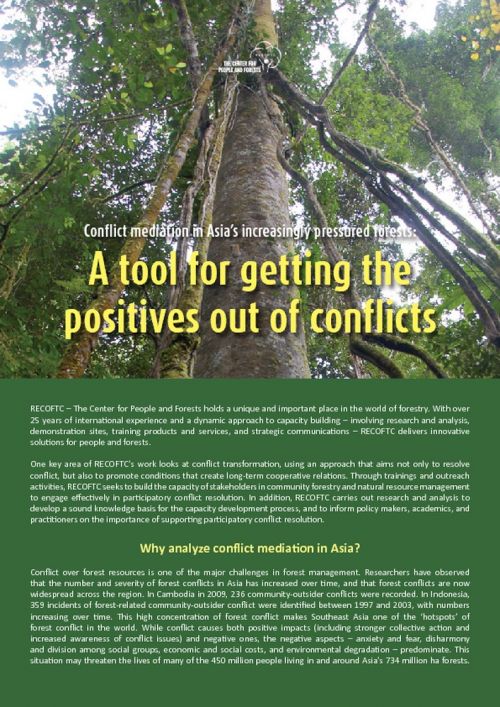APA 6th ed. Conflict Mediation in Asia's Increasingly Pressured Forests: A Tool for Getting the Positives out of Conflicts. (2012, June 1). Retrieved from https://www.recoftc.org/publications/0000046
MLA 8th ed. Conflict Mediation in Asia's Increasingly Pressured Forests: A Tool for Getting the Positives out of Conflicts. RECOFTC, 1 June 2012, https://www.recoftc.org/publications/0000046.
Chicago 17th ed. RECOFTC. 2012. "Conflict Mediation in Asia's Increasingly Pressured Forests: A Tool for Getting the Positives out of Conflicts." Published June 1, 2012. https://www.recoftc.org/publications/0000046.
Conflict Mediation in Asia's Increasingly Pressured Forests: A Tool for Getting the Positives out of Conflicts

Conflict over forest resources is one of the major challenges in forest management. Researchers have observed that the number and severity of forest conflicts in Asia has increased over time, and that forest conflicts are now widespread across the region. In Cambodia in 2009, 236 community-outsider conflicts were recorded. In Indonesia, 359 incidents of forest-related community-outsider conflict were identified between 1997 and 2003, with numbers increasing over time. This high concentration of forest conflict makes Southeast Asia one of the ‘hotspots’ of forest conflict in the world. While conflict causes both positive impacts (including stronger collective action and increased awareness of conflict issues) and negative ones, the negative aspects – anxiety and fear, disharmony and division among social groups, economic and social costs, and environmental degradation – predominate. This situation may threaten the lives of many of the 450 million people living in and around Asia’s 734 million ha forests.

